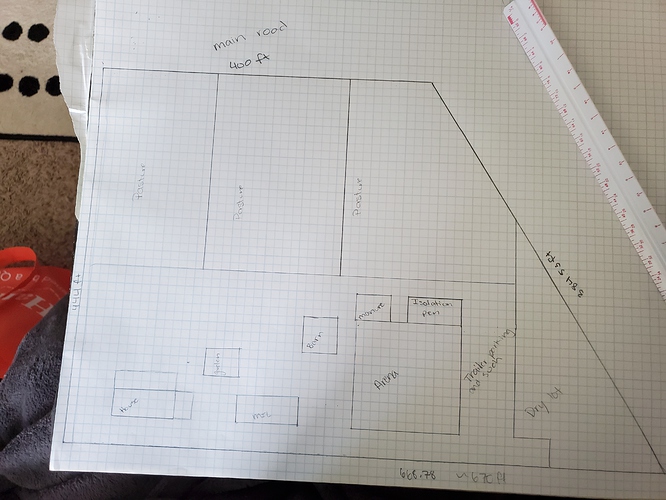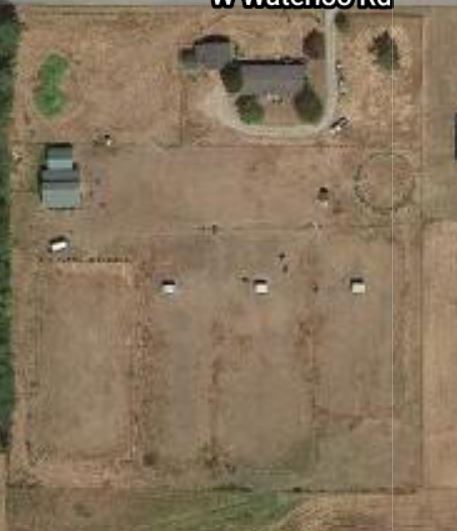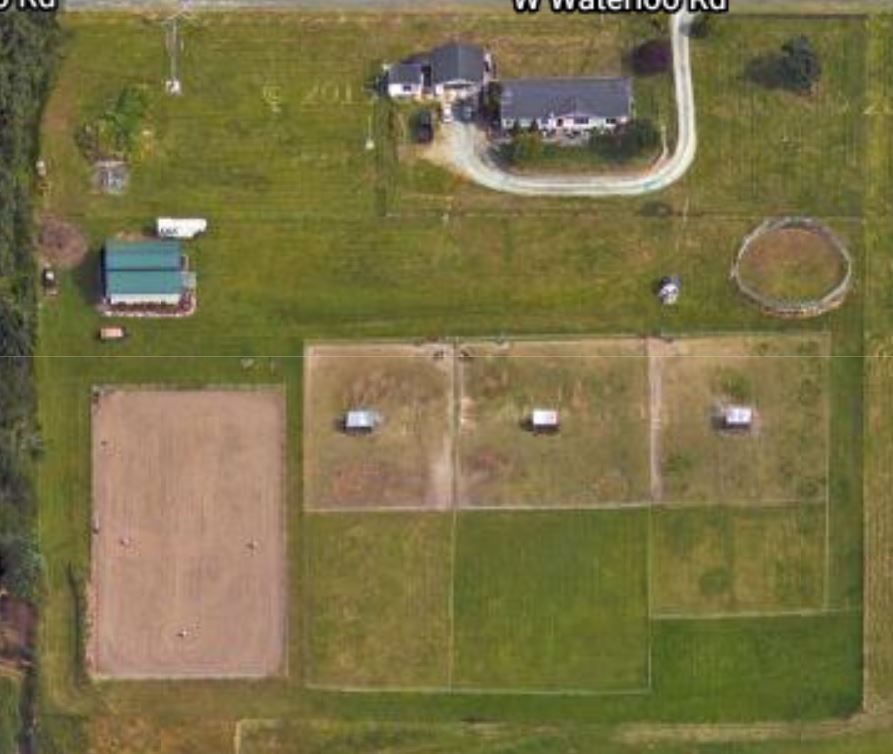Wet lands are going to make your pastures even less sustainable. (Are you even allow to graze them? Are they truly designated wet lands?)
We have checked and yes, we can graze on them. We walked around and looked them out but they aren’t actually very wet even with heavy rain. We will make sure how to plan around it.
I can’t imagine anyone is going to pay for such a small timber harvest. Take care that you cut trees up into their desired lengths (here pine must be at least 12’ long).
It will take a good long while to have the land settle after you rip out the stumps, so budget for a long boarding time OR definitely put in a couple of ‘dry lots’ so they can come home sooner.
Figure out how the hay delivery trucks and can get in out. Watch driveway angles and such. I have to snake my big trailer through a tree maze lol so much so that my layout freaks out most who visit it… I think of it as part of my security system 
I’m sure it will all work out but here are a few things to consider. Wetlands are not the same as an area that gets mushy after it rains. Often the water comes up from the ground, this depend on the water table etc. not so much day to day weather.
Make sure you can disturb the soil in that area before you begin removing trees. In my area developers can’t disturb ground designated as wetland (there is a way around it but it requires buying wetland acres elsewhere).
Your designated wetland area looks small. This may be the area where you keep the trees. Trees help stabilize the ground. You mentioned you’d like to keep some trees in the paddocks anyway. You’re already keeping the buildings out of the buffer, and you’ve checked about grazing. I’d check about the tree removal.
I want to add - when asking question on what you can and can not do on wetlands, do not ask your realtor or the developer. Ask someone who does not have an interest in you buying this piece of property.
Okay I will definitely look into that thank you!! There is quite a few trees in the wetland portion so I definitely agree with keeping trees there. Thank you! Now to try and redesign the plot again lol.
Have you tried talking to Horses For Clean Water?
I had a friend who did a demo barn and later boarded at another facility across the state. The mud-less runs are great.
I agree w/sacrifice paddocks, it will save your pasture.
Wetlands will be a challenge.
I have not talked to them. I will have to, thank you!
Here is a updated layout. What do you think? What could be added or taken away?
This looks like (3) half acre paddocks? Maybe I’m reading the numbers incorrectly or it’s not to scale?
It took me a bit to figure out your sketch versus the site plan.
I worry that all three of your pastures are going to be not usable more than they are usable since all of them are either wet land or wet land set back.
Having sharp corners in your dry lot is not optimal. With no grazing time (because that is what happens in a dry lot) the horses can get busy with other things and the ability to corner their herd mate into the two pie shaped wedges might lead to a problem. (I was OK with the quarantine paddock in the other design having weird wedges because most likely that would only have one horse in it.)
Your design still requires you to hand walk your horses from the barn to the pastures. Is that something you want to deal with?
Were you able to figure out the sizing? When I looked at the sketch it seemed like three half acre grass paddocks. I’m not familiar with the OP’s climate, but even here in FL where grass grows year round and the sand drains water away pronto, three half acre paddocks are not going to provide 24/7 grazing for 4 full size horses.
I believe so, by looking at the numbers. Though it looks like the angle the OP drew does not really match what is on the survey drawing and I have no doubt that the survey drawing is drawn to scale.
The 444’ property line is highlighted in yellow on the survey, I have highlighted it here.
I would assume that if the soil drained quickly it would not be designated wet lands with a 110’ buffer area.
I’m confused, I see where the main road is, is there a side road? I think I’ve lost the driveway.
did you rotate the orientation from the standard of North to the top to East being at the top?
So the side road is along the yellow highlighted line - 444’? Got it. That makes sense. Thank you.
I’m learning so much. Looking forward to putting my farm plan up for design help.
If I had to guess North is right on the site plan screen shot (because of the orientation of the lot numbers, which is the only text in that screen shot that would simply be drawn to read from the bottom of the sheet and the degree labels on the lot lines) and is up on the sketch the OP made.
But there really is no way of knowing which way North really is with no reference obvious on the site plan (since it is also very acceptable to have North to the right on a plan too).
Something I would consider is fencing the wetlands separately. If each pasture is part wetlands, that’s going to be a lot of traffic on land which might not be able to tolerate it and you may end up with half mud, half pasture. By fencing the wettest area separately, you can restrict access except for those times of the year the pasture can tolerate it. You’d be able to work around the wettest times.
That would mean splitting the pastures in the other direction.
If it were me, I’d only split the pasture with temporary fencing until I understood the land better.
You sound like you are in wet country, but just to be sure, beware of arenas or sacrifice paddocks close to the house/MIL house. So! Much! Dust! if it ever is dusty where you are. Better to have barn between dwellings and horses if it’s dusty. Better to have grass paddock between dwellings and horses, ditto.
You definitely want a sacrifice paddock. Also western WA here, and not even the wetter part (hurray rain shadow) and I bring my horses up off the pastures starting Oct-ish and they go back out end of March or early April depending on the year. I’m on my fourth year here and my pastures have been maintained nicely and not churned up, so they still grow enough grass that I have two in muzzles right now and one that will probably go into a muzzle soon. I really suggest you turn one of the paddocks into a dry lot (as suggested already as I scroll through while typing. I also like both of the suggested drawings @mmeqcenter made (now three I see  )
)
Agree. I just shipped a horse from out of state and my barn is a little full because my leased horse came back, and finding a way to QT the new horse was a bit of a juggling game.
As for logging, price of lumber is way up and you can probably easily find someone who will come in and take your trees. However you will be left with the stumps, undergrowth, and all the small limbs and junk they leave behind, and no grass for a while. I know other people can make this work in our climate but it isn’t easy and it takes some creativity.
ETA I see that you are very wet, if you are saying “wetlands.” Be aware this area will be unusable first and last. I have a small wet area (seasonal, from my neighbors’ small pond across my property to the large pond and designated wetland on my other neighbors’ property) and I still haven’t fenced that in to make anything grazable because each time I look at it I find another reason it won’t work. I had some friends who have since gotten out of horses and moved to a drier climate, they had small acreage (titch less than 5 acres) and individual turnout, and it stayed pretty nice year round, but they were fanatics about maintaining it (I mean seriously, fanatics). Like, picking manure every day from the turnouts, putting up temp fence to divide the small turnouts even smaller, and they still fed hay year round. Hang I used the historic tab and have two different pictures:
OK. but did you rotate the drawing from the first photo to the second as it appears you turned second drawing 90 degrees.
Just trying to understand what was shown.




